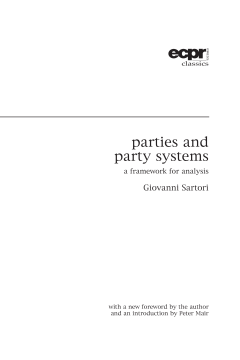
Additional Information
Book Details
Abstract
In this rich and broad-ranging volume, Giovanni Sartori outlines what is now recognised to be the most comprehensive and authoritative approach to the classification of party systems. He also offers an extensive review of the concept and rationale of the political party, and develops a sharp critique of various spatial models of party competition. This is political science at its best – combining the intelligent use of theory with sophisticated analytic arguments, and grounding all of this on a substantial cross-national empirical base. Parties and Party Systems is one of the classics of postwar political science, and is now established as the foremost work in its field.
Table of Contents
| Section Title | Page | Action | Price |
|---|---|---|---|
| Title Page | i | ||
| Copyright Page | ii | ||
| Series Page | iii | ||
| Contents | v | ||
| Tables and Figures | vii | ||
| Abbreviations | ix | ||
| New foreword by the author | xi | ||
| Preface to the 2005 edition | xii | ||
| Introduction by Peter Mair | xiii | ||
| Preface | xxi | ||
| PART ONE: THE RATIONALE: WHY PARTIES? | 1 | ||
| Chapter one: The party as part | 3 | ||
| 1. From faction to party | 3 | ||
| 2. Pluralism | 12 | ||
| 3. Responsible and responsive government | 16 | ||
| 4. A rationalisation | 21 | ||
| Chapter two: The party as whole | 35 | ||
| 1. No-party versus one-party | 35 | ||
| 2. The party-state system | 38 | ||
| 3. One-party pluralism | 42 | ||
| Chapter three: The preliminary framework | 50 | ||
| 1. Channelment, communication, expression | 50 | ||
| 2. The minimal definition | 52 | ||
| 3. An overview | 57 | ||
| Chapter four: The party from within | 63 | ||
| 1. Fractions, factions, and tendencies | 63 | ||
| 2. A scheme of analysis | 66 | ||
| 3. Southern politics: ‘Factions’ without parties? | 72 | ||
| 4. Italy and Japan: Fractions within parties | 78 | ||
| 5. The structure of opportunities | 82 | ||
| 6. From party to faction | 92 | ||
| PART TWO: PARTY SYSTEMS | 103 | ||
| Chapter five: The numerical criterion | 105 | ||
| 1. The issue | 105 | ||
| 2. Rules for counting | 107 | ||
| 3. A two-dimensional mapping | 110 | ||
| Chapter six: Competitive systems | 116 | ||
| 1. Polarised pluralism | 116 | ||
| 2. Testing the cases | 128 | ||
| 3. Moderate pluralism and segmented societies | 154 | ||
| 4. Twoparty systems | 164 | ||
| 5. Predominant-party systems | 171 | ||
| Chapter seven: Non-competitive systems | 193 | ||
| 1. Where competition ends | 193 | ||
| 2. Single party | 197 | ||
| 3. Hegemonic party | 204 | ||
| Chapter eight: Fluid polities and quasi-parties | 217 | ||
| 1. Methodological cautions | 217 | ||
| 2. The African labyrinth | 221 | ||
| 3. Ad hoc categorising | 226 | ||
| 4. The boomerang effect | 236 | ||
| Chapter nine: The overall framework | 243 | ||
| 1. System change, continuum, and discontinuities | 243 | ||
| 2. Mapping function and explanatory power | 251 | ||
| 3. From classification to measurement | 261 | ||
| 4. Measuring relevance | 267 | ||
| 5. Numbers and size: The index of fractionalisation | 271 | ||
| 6. Combining the nominal and mathematical routes | 281 | ||
| Chapter ten: Spatial competition | 289 | ||
| 1. The Downsian theory revisited | 289 | ||
| 2. Issues, identification, images, and positions | 292 | ||
| 3. Multidimensional, unidimensional, and ideological space | 297 | ||
| 4. The direction of competition | 305 |
